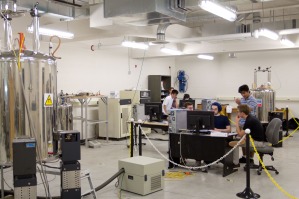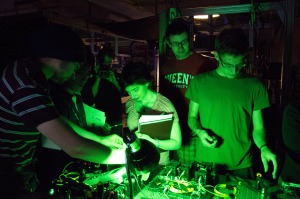We’re pleased to welcome a guest blogger to the Quantum Factory today — Miriam Diamond, a participant in the Undergraduate School in Experimental Quantum Information Processing (USEQIP), which is now in its second week at IQC. Miriam, a physics undergrad at Ottawa’s Carleton University, has become fully entangled in the quantum realm, and written a piece that boldly goes way beyond classical blogging. Enjoy!
A Qulog, by Miriam Diamond
Writing a classical blog at the Institute for Quantum Computing just wouldn’t seem appropriate. No, this place calls for a quantum version – clearly, a qulog. What, you may ask, are the properties of a qulog? Actually, the details are uncertain, even to the author. But I’m working things out as I go along, and here’s what I’ve got so far. Firstly, one can never assign the qulog an exact position and exact momentum at any given time, meaning one can never know exactly where the train of thought is at and exactly where it’s going. Conveniently for me, this means I can’t be blamed any for rambling or confusing passages. Secondly, it’s perfectly acceptable for the qulog to run around over multiple literary paths at once, and then interfere with itself at the end. Which makes it rather difficult for the reader to criticize the writing style. Thirdly, the qulog is in a superposition of saying all possible things at once, until you observe it. If you don’t like what it’s saying, don’t worry, there are many alternate universes in which the qulog is saying something you do like. Finally, if you really love the qulog and want to send it to a friend, you ought to transmit it only over a quantum-encrypted system – so, better go pay a visit to the IQC’s wonderfully talented QKD experts!

Working with fellow USEQIP participants in the IQC optics lab
Speaking of the IQC’s wonderfully talented experts, they have absolutely blown my mind this week. Not just with their brilliant ideas and deep understanding of their research fields, but also with their willingness to give their time and energy to students. Throughout my time as an undergrad, I had seen journal papers by these researchers, marvelling at their achievements and never imagining I would get the chance to even meet them. I could hardly believe it when these wizards stood up at the whiteboard and gave lectures to USEQIP, patiently explaining the difficult concepts step-by-step and cheerfully answering questions from us beginners. Their passion for their work quickly diffused through the room, and was rapidly absorbed by osmosis. Interference, decoherence, NMR, quantum algorithms, QKD… I could previously only get a fuzzy layman’s glimpse of the landscape, but now I had a tour guide to show me the details of what’s actually going on. Welcome to Alice (and Bob’s) Adventures in Quantum Wonderland! Hang on for a thrilling ride, and don’t be shy to ask questions.
It wasn’t just the lectures that were awesome this week. I also got the opportunity to do some lab work, in Optics and in NMR. It was an amazing feeling to rotate a beam displacer and watch the little laser dot disappear, or to put a sample into the NMR machine and watch the spectrum pop up on the computer screen. The quantum world is often considered highly esoteric and displaced from the experience of our everyday lives — but here was the power of the quantum world right at my fingertips, and under the guidance of expert magicians, I myself was holding the magic wand!
And of course, this qulog entry would be woefully incomplete without a mention of my fellow USEQIP participants, and the camaraderie I experienced this week. Up until now, I have often been the only person in the room fascinated by quantum mechanics. People would nod their heads politely at my attempts to explain the wonders of a wavefunction, while privately wondering what was with this bizarre obsession of mine. But at USEQIP, everyone else in the room is fascinated with the quantum world, too. Someone will mention a specific interpretation of quantum mechanics or a recent experimental result, and immediately, several other people will jump on the topic and start a lively discussion. And people even laugh at my quantum jokes! Well, some of them groan, but that’s beside the point. The point is that the entire institute has a wonderful atmosphere of, well, coherence. This was perhaps most evident at the Friday wine-and-cheese gathering, and at Thursday’s hockey game. (Quantum ball hockey: no penalties for interference, the playing field is discrete, and you’d better keep your eye on the ball since it goes into a superposition unless someone is observing it. Hey, I did warn you about my quantum jokes.) And there are people from various different disciplines – physics, computer science, math, engineering, etc. – each with their own contribution to bring to the Institute. Many individual particles, one powerful ensemble.
All in all, this week was a dream come true for me. Not just the lectures and lab setups (and free food), but also the little things. A faculty member taking the time to give me some valuable career advice, a grad student going out of his way to show me a piece of equipment, a table of people sharing a beer over a discussion of the double-slit experiment. I even got a picture with Freeman Dyson (an amazingly witty and brilliant man) when he dropped in to visit the NMR lab. And, I have now written my very first qulog — thanks for observing it!
Read Full Post »
 Waterloo’s scientific scene was well represented in the tiny Middle Eastern nation of Qatar today, as representatives from the Institute for Quantum Computing and the Perimeter Institute for Theoretical Physics delivered presentations at the World Conference of Science Journalists.
Waterloo’s scientific scene was well represented in the tiny Middle Eastern nation of Qatar today, as representatives from the Institute for Quantum Computing and the Perimeter Institute for Theoretical Physics delivered presentations at the World Conference of Science Journalists.








